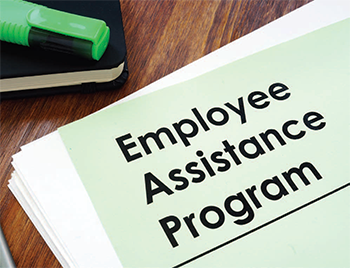Initiatives promote nurses’ well-being during the pandemic.
Ensuring nurses’ well-being isn’t just a concept for healthcare systems and organizations that have—or want to gain—the Pathway to Excellence® designation. Rather, it’s a standard that must be met and one that’s taking on even more importance as COVID-19 continues to plague communities throughout the nation.
Currently, 196 acute, long-term care, and other healthcare settings have demonstrated their commitment to positive practice environments for nurses by meeting the American Nurses Credentialing Center Pathway to Excellence Program’s six standards. The Pathway well-being standard, which was added to the 2016 application manual and strengthened in 2020, requires organizations to proactively safeguard and provide resources to support the mental and physical health of nurses and other staff, as well as recognize nurses’ contributions. It also specifies that organizations must address issues such as compassion fatigue, the well-being of those who’ve faced adverse events, and resilience.
The following interviews took place while COVID-19 was blanketing the country, including communities experiencing a second surge.
Offering support through tough times
Nursing leaders and staff at WellSpan Good Samaritan Hospital in Lebanon, Pennsylvania, found themselves in a challenging position in 2020.
“We’ve been on this incredible Pathway journey right in the middle of the pandemic,” said Patricia Donley, MSN, RN, NEA-BC, vice president of patient care services and chief nursing officer. Going through the application process at that time, however, allowed nurse leaders to identify gaps that existed in nurses’ work environments and then collaborate with staff to determine how to fill them. It also showcased strategies and activities to promote staff well-being and other positive practices that already existed in certain practice areas and expand them more widely throughout the system.
“We also wanted to show the awesome work nurses do every day and have them be recognized for their efforts,” Donley said. The pandemic did indeed strengthen community support for nurses and other frontline workers in Pennsylvania and nationwide.
Donley noted that within a couple of weeks of New York City being flooded with COVID-19 cases, Central Pennsylvania began its own surge. “Our hospital was one of the first within our health system to see a surge,” Donley said. “When our ICU began nearing capacity, we created a COVID-19 unit. It took a huge amount of energy [to get everything up and running].”
And while the entire community initially rallied around healthcare workers and first responders—putting up posters and billboards thanking them—as cases lessened regionally in late spring into summer so did public displays of support.
“But nurses still had to put on PPE [personal protective equipment], they still were facing stressors, and they were just exhausted,” Donley said. “That’s when we [nurse leadership] felt we needed to step in with more support and resources to address nurses’ well-being beyond what was put in place during the first wave.”
Nurse leaders asked nursing staff to express their concerns on Post-it notes that subsequently filled the walls of a designated room. Among the most significant were workload, the drop-off of recognition for their efforts, and how they were feeling—the mental and physical toll the pandemic had taken on them.
“It really illustrated what they went through,” Donley said. And it formed a basis for actions that have been helping all staff, and particularly those providing care to COVID-19 patients, as the hospital began experiencing the second surge of cases.
One of the first actions involved creating a high-impact response team composed of counselors who nurses and other staff could talk with about their feelings. “Our nurses have so many stressors beyond those that are work-related,” Donley said. “They have kids, wives, husbands—and are concerned about their families’ well-being.”
Bonnie Pietruch, MSN, RN, NEA-BC, director of clinical services and the Pathway coordinator, added, “It’s been really challenging for nurses who’ve been seeing the same acuity of patients on the COVID-19 unit since spring, and now we are in the second wave.” Unlike the first time, this wave is occurring as normal hospital operations continue in surgical and interventional care areas. During the spring, staff from those care areas were redeployed to assist with patient volume and acuity.
However, they’re now using non-nurse staff to serve as runners who can remain out in the hallways and re-stock supplies and engage in other supportive tasks. The facility also is using trained sitters who can provide needed relief to nurses, and it has boosted its use of video monitoring of patients, according to Pietruch.
After a survey by one nurse manager revealed that many nurses weren’t getting 7 hours of uninterrupted sleep each night, the hospital instituted and promoted a napping protocol for night staff and identified a space where exhausted nurses could rest before driving home.
To address the drop-off in nurse recognition, Pietruch and Donley are finalizing plans for an initiative to ensure nurses’ contributions are acknowledged and honored.
Although some health and well-being efforts were already in place before the pandemic, including many health promotion activities initiated by staff on various units and departments, WellSpan Good Samaritan, which earned the Pathway designation, has promoted more healthy food choices and offered individual grab-and-go bags. The organization also has increased nurse leadership rounds to gain feedback from staff and are trying to increase “stoplight reports” to keep staff informed about the status of their suggestions and concerns.
All that said, the nurses acknowledge they still face challenges, including scheduling and supporting nurse managers who also are feeling the stress of not being able to fully accommodate their staff.
“Our priority needs to be the team members who are all doing such incredible work and who need to be supported,” Donley said. Added Pietruch, “One of the most important things [nurse leaders] can do is to listen, acknowledge nurses’ needs, and take action whenever we can.”
Addressing compassion fatigue
Meanwhile, in the Tampa Bay, Florida area, the number of discharges and admissions of COVID-19 patients has remained generally steady, according to Sarah Perron, PhD, RN, NPD-BC, CMSRN, CNML, who serves as manager of clinical professional practice for six hospitals and works with the Pathway liaison at eight others within the BayCare Health System. All of BayCare’s hospitals have earned the Pathway designation and have bedside nurse representatives from each facility on a wellness champion committee that addresses health and well-being initiatives.
Shortly after the first surge of COVID-19 patients, Perron said nurse leaders began thinking about ways to address compassion fatigue and burnout. As a first step, nurses were surveyed through Voices for Extraordinary Care, an online community group of all BayCare nurses.


Since then, the EAP, which also is available to employees’ family members, has expanded its hours, and facilities have engaged their missions (pastoral care) teams to quickly respond to staff experiencing compassion fatigue and related issues. BayCare also has critical incident teams to assist team members who’ve gone through adverse events, as well as behavioral health department staff who provide expertise.
Limitations on visitors for COVID-19 patients added to nurses’ roles and stress during this pandemic. “Nurses normally rely on family support for many of our patients, especially in critical care areas,” Perron said. “Many nurses have voiced that they’ve never taken care of such complex patients and having to update family members using cell phones and FaceTime adds another layer of complexity, especially when patients are dying. It’s very emotional.”
Rocky Hauch, DNP, RN, PCCN, said he’s seen more nurses speaking with chaplains and also using wellness (quiet) rooms to momentarily get away from the stress of taking care of critically ill patients. Additionally, nursing leaders have made a point to be on the floor more to gain nurses’ direct input on their ongoing needs, said Hauch, a former long-time floor nurse and charge nurse on cardiac and med-surg telemetry units who now works per diem shifts at BayCare St. Joseph’s Hospital in Tampa.
Perron noted outside resources—such as the American Nurses Association (ANA) webinar on compassion fatigue and the ANA Enterprise’s Healthy Nurse, Healthy Nation™ initiative—also can be used to support nurses’ well-being at this time. “As leaders, we’re trying to figure out how we can bring ANA resources to bedside nurses—some who might not be aware that they are experiencing compassion fatigue. We’ve integrated them into team meetings when possible,” she said. “We really want our nurses to know we value their health and well-being.”
BayCare facilities also have shifted employees in certain departments to serve as runners for nurses working with COVID-19 patients, and have hired more travelers to address staffing needs, according to Perron.
In addition, BayCare has continued to recognize its nurses and staff through its own Clinical Excellence Awards and the national Daisy Awards, as well as showing support for staff through public displays of support.
A recent recipient of a Clinical Excellence Award, Hauch emphasized the critical link between nurses’ health and patient care. “Nurses’ health and well-being are paramount to providing quality care,” said Hauch, a member of the Florida Nurses Association and the Commission on Pathway to Excellence. “During this pandemic, it is even more important. This is when our patients are the sickest and resources are being stretched to the maximum and sometimes beyond. Speaking more broadly, without adequate health, rest, and personal well-being, nurses will not be able to provide the high-quality, compassionate care that our patients deserve.”
Supporting nurses’ mental health and well-being resources
To address nurses’ health and well-being now and in the long-term, the ANA Enterprise offers a range of free, on-demand educational resources. A few are listed below.
ANA COVID-19 Video Education Series
(bit.ly/34PmYCg)
“Effective Tools for Practicing Self-Compassion and Self Care in the Time of COVID-19”, part of the ANA COVID-19 webinar series, provides important tools that all nurses can use to help maintain mental well-being while facing the ongoing challenges presented by caring for COVID-19
patients.
Mental health support webinars
(tinyurl.com/ya4buejw)
“Mental Health Support: How to Survive the Pandemic with an Unbroken Spirit” offers ways to successfully manage your mental health needs while caring for COVID-19 patients. Watch the full 60-minute webinar or select from shorter, 15-minute quick videos.
ANA’s Self-Care Package for Nurses
(tinyurl.com/y7nvyxke)
“A Nurse’s Guide to Preventing Compassion Fatigue, Moral Distress, and Burnout” (tinyurl.com/yaw7y5yw) is one of several handpicked offerings in ANA’s Self-Care Package for Nurses to help RNs during and after this crisis.
To register for these free, on-demand courses, visit nursingworld.org/coronavirus.
Well-Being Initiative
In partnership with other leading nurse organizations, the American Nurses Foundation launched the Well-Being Initiative, which offers tools and apps to support the mental health and resilience of all nurses, go to nursingworld.org/thewellbeing-initiative.
Thank you
We at the American Nurses Association (ANA) wish to express our sincere appreciation to Susan Trossman, RN, for her contributions as a writer and editor for more than 23 years. With originality, dedication, and passion, Susan chronicled the challenges and triumphs of RNs, the nursing profession, and ANA for our readers. She has been an esteemed colleague who will be missed. We wish her a happy, healthy retirement.
— At the time this article was written, Susan Trossman
was a writer-editor at ANA.




















